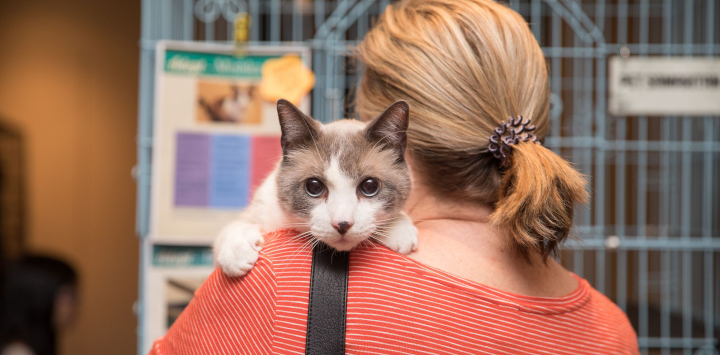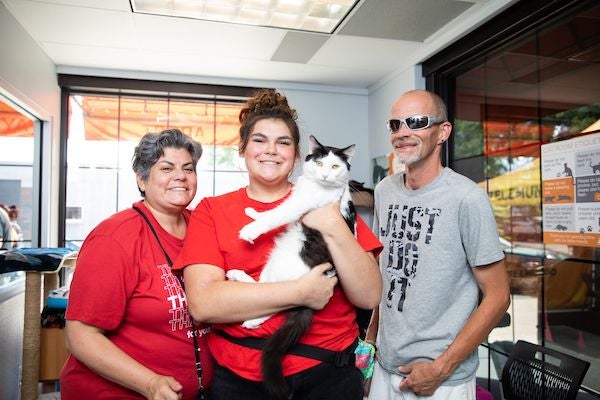
Municipal shelters share strategies for increased adoptions in 2022
December 13th, 2022
A few weeks ago, Brent Toellner’s editorial, “The reality of today’s shelter struggles,” touched on some of the data behind this year’s intake and outcome trends. It probably was no surprise that this was a challenging year – especially for municipal shelters. Sure, organizations of all kinds experienced increases in the number of cats and dogs coming through their doors. But shelters with municipal contracts bore the brunt of the uptick, “with 13.2% more dogs…coming through the doors compared to 2.8% at private shelters.”
To cope with this reality, munis leaned hard into proven tactics to move out as many animals as possible, as quickly as possible. As a result, they outstripped private brick-and-mortar shelters (both with and without contracts) in adoptions, particularly for dogs. In fact, municipal agencies saw a 17% increase in their canine adoptions compared to private organizations with contracts, which were up by 2%. Private organizations without contracts saw a decrease of 1.9%.
 When we posted a link to the piece on the Best Friends Lifesaving Resource Hub Facebook page, it generated a fair number of comments. One person noted that while the editorial lauded municipalities for the increase in adoptions, it didn’t share specifics about how they were achieving those increases so that private organizations could follow in their footsteps.
When we posted a link to the piece on the Best Friends Lifesaving Resource Hub Facebook page, it generated a fair number of comments. One person noted that while the editorial lauded municipalities for the increase in adoptions, it didn’t share specifics about how they were achieving those increases so that private organizations could follow in their footsteps.
Brent’s advice?
“Beyond the marketing and events, I'd encourage you to look at any barriers that might be in place for adoption,” he says. “Things like landlord checks, veterinary checks, intrusive screening questions can really turn adopters off. Additionally, look at things like your adoption hours to be sure they are adopter-friendly, and be sure you're providing the best customer service possible.
“I've talked to several shelter directors who found barriers that crept up during the pandemic that they needed to undo, and it's a good time to look to see if there are any in your organization,” he adds. “I'd also love to hear from some of our municipal shelter friends or shelters that are bucking the trend to hear what they're doing.”
So, we asked them, and they were happy to share the practices that helped them find homes for more dogs this year. Although several respondents noted that “they are not doing anything special or out of the ordinary,” what they are doing bears repeating so that more organizations can find positive outcomes for the dogs and cats in their care in 2023 and beyond.
Considering context
Before we dig into what changed for many municipal agencies this year, let’s examine some of their challenges. Yes, part of what made 2022 problematic was the increase in numbers. For instance, Dallas Animal Services (DAS) accepted 12,237 dogs and 2,238 cats in fiscal year 2021, and that number bounced up 16% for dogs (14,169) and 9% for cats (2,444) this year. But DAS also found it had fewer tools to generate positive outcomes for those animals due to a dip in transfers.
Our rescue pulls are dramatically down,” says Marlo Clingman, DAS’s public information coordinator. “Groups pulled 1,925 dogs and 930 cats in fiscal year 2021, but that dropped to 1,296 dogs and 652 cats in fiscal year 2022. That’s 33% fewer dogs and 39% fewer cats.
Florida’s Broward County Animal Care (BCAC) also saw a decrease in partner transfers year over year. In 2021, 952 animals went to other agencies (20% of BCAC’s outcomes); that figure dropped to 591 (18%) in 2022. BCAC director Emily Wood wonders whether that is due to transfer partners taking in more animals directly from the public, perhaps even those animals diverted from the municipal shelter.
“Instead of automatically accepting every stray or owner surrender, BCAC is now asking the owner or finder to perform certain tasks first, like knocking on doors in the area where the animal was found,” she says. “We also have a foster-to-adopt program where people take these dogs home during their stray hold with the promise of returning them should an owner come forward. So far, it has been very successful. All returns have happened without drama – though maybe a few tears.”
While these are seen as progressive, proven practices for shelters, Emily considers that one unintended impact is that partners are taking in adoptable animals whom we know could be placed into new homes directly by their owners or finders with BCAC’s support.
 “Additionally, transfer partners may be accepting cohorts of animals that are more marginal to their programs,” she says. “Are they taking animals with greater needs, which then slows those organizations’ placement rate? For example, we had a contract with a partner who began taking in any small dog from our facility, as they had a quota in exchange for a rental property. That included small dogs with medical needs. While they had foster spaces for those dogs, they did not have the resources to cover medical care. They came close to going out of business.”
“Additionally, transfer partners may be accepting cohorts of animals that are more marginal to their programs,” she says. “Are they taking animals with greater needs, which then slows those organizations’ placement rate? For example, we had a contract with a partner who began taking in any small dog from our facility, as they had a quota in exchange for a rental property. That included small dogs with medical needs. While they had foster spaces for those dogs, they did not have the resources to cover medical care. They came close to going out of business.”
Milwaukee Area Domestic Animal Control Commission (MADACC) executive director Karen Sparapani says rescues in her area are more likely to receive transports from other communities. Some of those who do pull from MADACC tend to “cherry-pick” from the population to such a degree that the shelter made the decision to change its policies and limit the groups it works with.
“Some groups choose all the highly adoptable dogs and leave the seniors, pitty mixes and cats, which we struggle to adopt out,” she says. “So, we started to only work with groups who took dogs with medical needs, or who did not care about breed. By doing so, we were able to bring in more adoption traffic and adopted out more animals overall.”
Investing in adoptions
No matter if it’s money or people, shelters are investing resources into adoptions – and seeing results. Memphis Animal Services (MAS) began paying to advertise both adoption and fostering in March of this year, which has kept adoption traffic steady outside of big promotions like the National Adoption Weekends Best Friends supported this year.
The focus is not just on adoptions, either, because keeping our foster numbers up ultimately helps our adoption numbers,” says marketing and communications supervisor Katie Pemberton.
 The City of Amarillo Animal Management and Welfare (AAMW) in Texas works with local media as well, though the shelter gets free weekly ad spots to promote pets. It also made the choice to dedicate staff – and office space – to adoptions, something that didn’t exist before last year.
The City of Amarillo Animal Management and Welfare (AAMW) in Texas works with local media as well, though the shelter gets free weekly ad spots to promote pets. It also made the choice to dedicate staff – and office space – to adoptions, something that didn’t exist before last year.
“We were way behind the eight ball with regard to adoptions,” says Kris Shaffer, assistant director. “We didn’t have an adoptions office, or even an adoptions team. Until 2021, the intake team was doing adoptions in addition to their many other duties.
“Once we began assembling a dedicated adoptions team, our numbers really started to pick up,” he continues. “We were able to devote time to match-making and meet and greets, where there were none before. A couple of months after hiring the full team in early 2021, we were able to renovate a space for them to work out of exclusively. That made the whole experience much more enjoyable for adopters, as well as for the team.”
AAMW also partnered with a local pet store for cat adoptions, which has been wildly successful.
“We came from doing essentially nothing to get pets adopted, to running a healthy adoptions program with an outreach/media aspect,” he says. “While pretty basic, what catapulted us into a much better place was having people dedicated to the adoption process.”
Clearing the hurdles
Dedicating more resources to adoptions will only go so far, however, if old practices remain in place. With millions of pets waiting for homes in shelters, rescues need to figure out ways to reduce or eliminate the hoops adopters must jump through to acquire a pet.
Whether that’s reducing fees, ending home checks, allowing trial adoptions, trimming down your application length, or something else, you’d be surprised how making it easier to adopt will allow all of us to save more lives,” Katie says. “The perfect home doesn’t exist, but there are a whole lot of great ones out there you might be missing out on.
She also encourages rescue groups to look at where their application bottlenecks are and start there.
 “Maybe it’s the logistics and scheduling of home visits, in which case my personal recommendation would be to eliminate those completely,” she says. “If that’s too much for you, a good place to start might be to make them virtual, which would make the logistical part simpler and probably enable you to schedule and complete them more quickly. It would also feel less invasive to potential adopters, some of whom may be uncomfortable or afraid to invite a stranger into their home.”
“Maybe it’s the logistics and scheduling of home visits, in which case my personal recommendation would be to eliminate those completely,” she says. “If that’s too much for you, a good place to start might be to make them virtual, which would make the logistical part simpler and probably enable you to schedule and complete them more quickly. It would also feel less invasive to potential adopters, some of whom may be uncomfortable or afraid to invite a stranger into their home.”
“What are you doing to welcome new and different types of adopters, volunteers and fosters to your network?” asks Marlo, whose shelter has a first-come, first-served, open adoptions policy. DAS also does not do background or home checks or ask for proof of home ownership or landlord letters. It also accepts all forms of photo ID.
“How can you make current supporters of diverse backgrounds feel more included and that their voices are reflected in your efforts?” she asks. “Is your application accessible to those who might have language barriers, learning disabilities or physical disabilities? Are your adopters from diverse walks of life, or do they all come from the same social class or ethnic makeup?”
Emily says if she has one piece of advice for groups that want to increase adoptions, it would be to throw away your application. It’s worked for BCAC, which did 3,013 adoptions in 2022, up from 2,284 last year.
Say yes to everyone,” she says. “Zero judgment, 100% of the time
Finally, many shelters are making the decision to reduce or eliminate all fees. DAS made the decision to waive its adoption fees for all of 2021 and 2022, while MAS ventured into free adoptions for the first time ever during the May Best Friends National Adoption Weekends.
While such choices can be scary, Marlo urges organizations that are hesitant to just “fling open the doors to any adopter to just try it.
“Our open adoption policy and free adoptions have had no impact on return rate or the quality of homes,” Marlo says.
Prioritizing transparency
Speaking of scary, more shelters are practicing full transparency with the public and reaping the benefits. In August, MAS started the Deadline Plea process to inform the public about dogs at risk of euthanasia.

“On Mondays and Fridays, we post a video of all the dogs who need adoption, foster or rescue commitment before the deadline,” Katie says. “Being clear about how much time those dogs have has helped increase their positive outcomes and many of these dogs have very manageable/treatable behaviors that are specific to shelter life.”
Kocoa is one such example. She was surrendered to MAS in early October because her person was having housing difficulties. Although the shelter does offer placement assistance, Katie notes that MAS can’t help if a pet parent literally can’t find any affordable place to live that won’t allow any pets or won’t allow their specific pet.
“From the very beginning, Kocoa found the shelter environment challenging,” she says. “She hid under her mom’s chair and growled at shelter staff, who opted to delay vaccination and putting an ID collar on her at that time due to how upset she was.”
To help Kocoa through the transition, MAS’s assistant shelter supervisor made her an office dog.
 “We knew that she would have a high level of fear anxiety and stress, so it was important to keep her out of the loud kennel area as much as possible,” Katie says. “We also immediately put her on the list to receive additional enrichment immediately. She also went on our at-risk list, which is a preliminary step before a dog goes on a Deadline Plea and basically means this dog needs additional resources. They need to be seen. They need help.”
“We knew that she would have a high level of fear anxiety and stress, so it was important to keep her out of the loud kennel area as much as possible,” Katie says. “We also immediately put her on the list to receive additional enrichment immediately. She also went on our at-risk list, which is a preliminary step before a dog goes on a Deadline Plea and basically means this dog needs additional resources. They need to be seen. They need help.”
And that’s what happened. A family saw that Kocoa was at risk and stepped up to foster her. Within a week, they decided she was home.
“Her new mom reported that she is such a joy and has brought so many laughs and so much happiness in just a short amount of time,” Katie says. “She’s the biggest cuddler; she loves her treats; and car rides are her absolute favorite thing in the world! She has a human brother and sister who she absolutely adores, but she’s completely attached to her adoptive mom. The woman also told us that Kocoa is her shadow and newfound best-friend!”
Taking a chance on change
While many commenters on the Facebook post felt the editorial unfairly targeted rescue groups, the reality of sheltering has meant municipal agencies can’t afford not to try new, scary practices.
“I’ve worked at both a private shelter and a municipal shelter, and I can say from experience, I didn’t experience the same sense of urgency at the private shelter,” Katie says. “You truly just can’t know what that’s like until you’ve been in the situation.
I think for municipal shelters, necessity is the mother of invention. Our adoptions are up because they have to be.
Emily believes that part of the reason for the widening gap between shelter practices and those of groups without contracts is that the latter don’t feel the same kind of ticking-clock reality.
 “I don’t know how we close that gap, since so much of it is philosophical,” she says. “And I don’t know that we did anything wrong – could we have anticipated how this would play out when we began doing diversion programs in an attempt to manage the influx? But we probably have to invite folks to more conversations, particularly now that they are likely experiencing what we were on the leading edge of experiencing.”
“I don’t know how we close that gap, since so much of it is philosophical,” she says. “And I don’t know that we did anything wrong – could we have anticipated how this would play out when we began doing diversion programs in an attempt to manage the influx? But we probably have to invite folks to more conversations, particularly now that they are likely experiencing what we were on the leading edge of experiencing.”
Make no mistake, even with their encouraging adoption numbers, every shelter that shared their advice here is grappling with what else they can possibly do to avoid having to make hard choices.
“Shelters all over Texas are really hurting this year,” Marlo says. “Despite our increase in adoptions, a 35% increase in our foster base this year, and us hitting our goal of a 90% live release rate during fiscal year 2019-2020, we are back to euthanizing healthy, adoptable dogs for space.
“We would appreciate any help we can get from national and local rescues so we can get back on track for our mission to #BeDallas90 – to hit that “no-kill” positive outcome threshold and maintain it.”
As an industry, we know what works to drive adoptions: better and more aggressive marketing, removing barriers and making adopting or fostering accessible to diverse communities and improved customer experience.
“I think now, more than ever, we all need to work together to increase our adoptions and help keep animals moving to save more lives,” Brent says. “There isn’t a magic bullet and it’s not fancy, but getting back to the basics of improving adoptions will help get us there."

Liz Finch
Senior Writer
Best Friends Network
If you enjoyed this program spotlight, you can find our complete catalog of spotlights here.